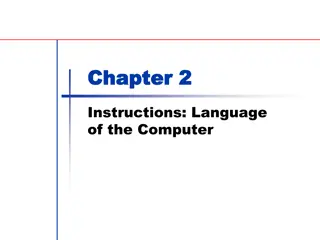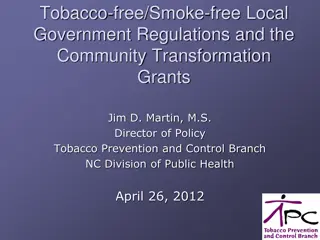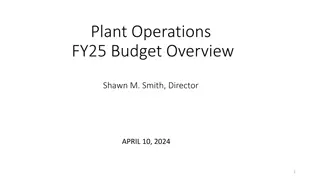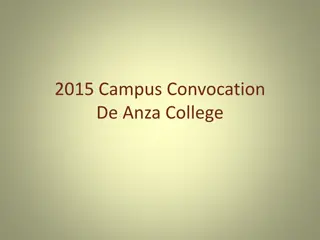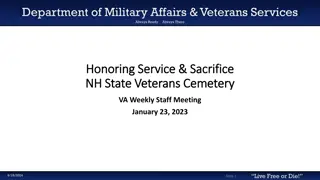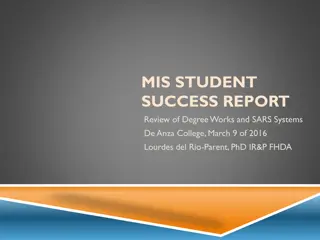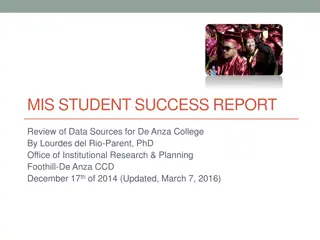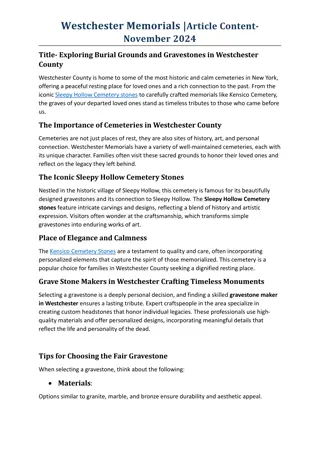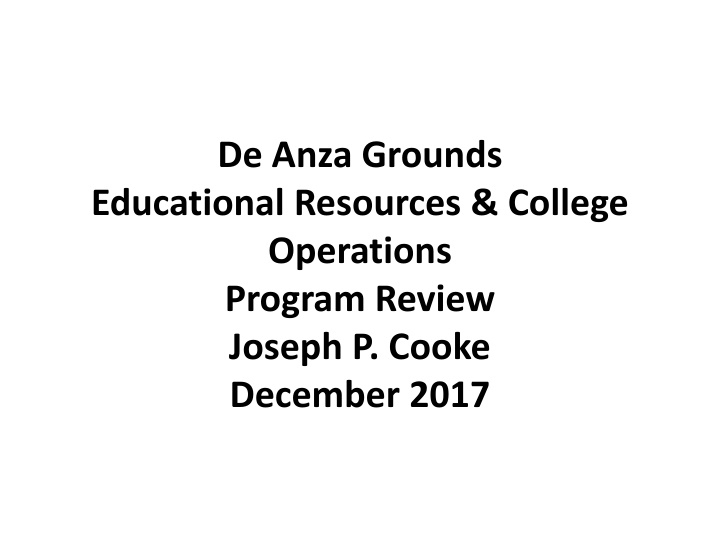
De Anza Grounds Department Operations Overview
The De Anza Grounds Department at De Anza College is tasked with maintaining a safe, clean, and aesthetically pleasing campus environment. They manage a variety of tasks including landscaping, waste disposal, and event setup. The department focuses on sustainability efforts such as composting and recycling to minimize environmental impact.
Download Presentation

Please find below an Image/Link to download the presentation.
The content on the website is provided AS IS for your information and personal use only. It may not be sold, licensed, or shared on other websites without obtaining consent from the author. If you encounter any issues during the download, it is possible that the publisher has removed the file from their server.
You are allowed to download the files provided on this website for personal or commercial use, subject to the condition that they are used lawfully. All files are the property of their respective owners.
The content on the website is provided AS IS for your information and personal use only. It may not be sold, licensed, or shared on other websites without obtaining consent from the author.
E N D
Presentation Transcript
De Anza Grounds Educational Resources & College Operations Program Review Joseph P. Cooke December 2017
Mission The Mission of the Grounds Department is to provide safe, clean, aesthetically pleasing and professionally well maintained campus grounds; grounds that are environmentally safe, conducive to life-long learning and user friendly to students, faculty, staff and visitors.
Role and Function The DA Grounds department functions as the keepers and stewards of the 112 acres that comprise the De Anza College grounds. As such the unit is tasked with the following service functions; picking up trash, *garbage collection, *recycling collection, cleaning storm drains, planter beds as well as planting, pruning, trimming, mowing and the general care and maintenance of the campus plant life. The DA Grounds department also performs tasks that are not explicitly within the scope of the department yet are important to college life, such as hanging banners, pulling out bleachers in the gym and seasonal equipment setup and storage for the Athletic Department. The Grounds department takes a major role in the annual commencement ceremony, preparing campus grounds to look it s best for the students and families taking part in graduation and preparing the stadium field by laying a special flooring over the field to protect the artificial turf from the contractors construction of the stage and the seating setup for several thousand visitors. *Grounds working in cooperation with the Custodial Department and our refuse hauler Recology . We have streamlined our recycling process composting and waste disposal methods to maximize recycling using single-stream , increasing the diversion percentage from our waste stream. Using compactors rather than roll-off containers or dumpsters significantly reduces the carbon footprint . Enhancing the composting program by transferring the process from on-campus collection and composting to Recology s offsite composting facility, significantly increases the type and amount of material we compost from approximately 2 tons of kitchen scraps per month diversion, to a much larger percentage of the overall waste stream, while allowing for the incorporation of compost mulch from Recology into the campus landscape.
Descriptive Summary Currently the Grounds Department is staffed with six FTE Grounds Gardener and Grounds Maintenance staff members maintain a total of 81.8 acres or 13.63 acres per Grounds Gardener/Maintenance staff member. This is up from an original 9.09 acres per staff member prior to budget cuts and staff reductions in 2008. Functionally the 81.9 acres are used in the following manner: Landscaped area Athletic Fields/Facilities 28.5 acres 10.1 acres 43.2 acres 81.8 acres The remaining 30.2 acres are buildings. Parking Lots and Roadways Along with the Grounds Supervisor six Grounds positions fall into the following classifications: 1 Grounds Gardener I 1 Grounds Gardener II 2 Grounds Gardener III 2 Grounds Maintenance (equivalent of Grounds lll w/Custodial training) The Grounds Supervisor manages the unit, prioritizing and scheduling the daily and seasonal work assignments. Shifts 5:30 A.M. 2:00 P.M. Grounds Supervisor: Monday-Friday 6 A.M. - 2:30 P.M. 5 A.M. - 1:30 P.M. 6 A.M. -2:30 P.M. 1 crew members: Monday-Friday 4 crew member: Monday-Friday 1 crew member: Tuesday-Saturday
De Anza Community College Grounds Organizational Chart as of December 2017 Joseph Cooke Supervisor Grounds Head Grounds Gardener Position Eliminated Juan Hernandez Grounds Gardener II Eduardo Mendes Grounds Gardener III Irrigation Specialist Position Eliminated Francisco Hernandez Grounds Maintenance Adam Contreras Grounds Maintenance Campus Center Jason Sousa Grounds Gardener I Francisco Garfias Grounds Gardener III Grounds Gardener Position Eliminated
Strengths Crew members with long term familiarity of campus infrastructure. Crew members with professional training in horticultural and plant husbandry. Crew that is dependable and available for seasonal events. Flexibility that promotes the efficient use of time and staff resources. Ability to respond to emergency situations quickly. Ability to organization the crew into a single cohesive work team for greater productivity with a variety of seasonal landscape projects. A proactive seasonal maintenance program for native plant material as well as a detailed an inventory of trees based on size, species and biological condition. Computerized campus-wide irrigation system with on campus weather station that automatically adjusts water use based on campus micro-climate and individual plant species requirements.
Weakness A percentage of staff that lack of professional training in horticultural and plant husbandry. Shortage of staff with specific technical irrigation and horticultural skills. Limited ability to institutionalize calendar of major work tasks i.e., very limited time to accomplish work without conflicting with the academic calendar. We continue to have a percentage of antiquated irrigation systems requiring manual operation and continuous ongoing repairs. Large population of trees needing seasonal and structural pruning by contractors certified in tree work, having knowledge and experience through the International Society of Arboriculture, and ISA standards (outsourced).
horticultural education background, the department has lost its Head Grounds-Gardener position, an Irrigation Specialist as well as 2 Grounds Gardeners with long term familiarity of campus grounds. With additional landscaped areas brought on line through Measure C building and renovation projects the impact from the loss of these positions becomes more obvious, leading to the re-instatement of one intermediate level Grounds Gardener position using one-time funds for 3 years. Certain key equipment purchases have the affect of partially offsetting the loss of FTE s by helping to increase the productivity level of remaining staff. Investing in new electric carts has improved our safety and labor productivity by more efficient transport of equipment and supplies as well as greater functionality in the hauling and disposal of garbage and compostable yard debris such as leaves. Historically DA Grounds has been limited to using blowers to clean leaves and debris from walkways and patios. Measure C added a significant number of large-leaf deciduous trees, i.e., the sycamore trees throughout the Main Quad, Parking Lot C and Parking Lot A. This seasonally increases the amount of leaves, pollen and other debris in and around several patios and campus walkways. Purchasing industrial outdoor vacuums will aid in the cleanup and disposal of leaves, pollen and other debris particularly on and at the perimeter of these patios having a significant number of new trees. The use of a walk behind industrial outdoor vacuum in conjunction with leave blowers helps keep these areas cleaner and allow for more efficient hauling and disposal. Certain equipment formerly supplied through the District was until recently no longer available for DA Grounds department use. For instance, several landscape repair and installation projects related to Measure C landscape renovations require a plate compactor and demolition hammer no longer available. Irrigation installation and repair projects necessary due to Measure C renovations require the use of a demotion hammer to aid in the excavation of broken irrigation pipes and valves. The replacement of an antiquated demolition hammer and the purchase of a plate compactor, recently a high priority for DA Grounds, now allows the DA Grounds department to more efficiently repair irrigation and work toward the completion of irrigation and landscape improvement projects in several areas throughout campus. Although the Grounds Department has a supervisor with both field experience and
Quantitative Measures The Grounds Department has quantitative workload service level measurements based on specific tasks. Evaluating tasks for each area is a functional characteristic of the particular type of grounds area, e.g., parking lots and roadway acreage, landscaped acreage or athletic facilities. Two essential factors determine staffing requirements for the particular type of Grounds area. The first is the type of area that must be maintained and the tasks associated with that area e.g., sweeping parking lots and roadway acreage or trimming shrubs in the landscape, and mowing athletic fields. The second is the amount of care provided based on functional characteristics. Integrating these two essential factors facilitates the determination of priorities in the staffing requirements for a particular type of area. The type of areas along with their functional characteristics can be maintained at a standardized level of attention by adjusting the amount of time dedicated to the maintenance tasks associated with the type of area and its functional characteristics or by adjusting the amount of staff dedicated to the maintenance tasks or doing both.
Standardized Levels of Attention APPA: The Association of Higher Education Facilities Officers has quantified workload measures into six standardized levels of attention . LEVEL 1 State-of-the-art maintenance applied to a high- quality diverse landscape. Associated with high- traffic urban area, such as public squares, malls, government grounds, or college/university campuses.
LEVEL 2 High-level maintenance. Associated with well- developed public areas, malls, government grounds, or college/university campuses. Recommended level for most organizations. LEVEL 3 Moderate-level maintenance. Associated with locations that have moderate to low levels of development or visitation, or with operations that, because of budget restrictions, cannot afford a high level of maintenance.
LEVEL 4 Moderate to low-level maintenance. Associated with locations affected by budget restrictions that cannot afford a high level of maintenance. LEVEL 5 Minimum-level maintenance. Associated with locations that have severe budget restrictions.
Grounds Staffing Guidelines Previous staffing reductions dictate the level of attention the De Anza Grounds Department can provide. Diligent organization, prioritizing high traffic areas and supervision assigning regular work schedules to a cohesive team of dedicated staff can support a higher level of service, particularly in areas where recent construction and landscape renovations with the development of more sustainable native plant species having designs with low or minimal maintenance requirements are incorporated into the campus infrastructure. De Anza Grounds can in some areas continue to maintain the landscape at a Level 2 with regard to APPA standards. In most instances maintenance of Grounds related functions remain at a Level 3 , mainly due to previous infrastructure upgrades such as our computerized irrigation system with automatic weather station adjustments and the re-instatement of one intermediate level Grounds Gardener position using one-time funds for 3 years. Any significant degree of absenteeism or reductions in staffing dictate that certain areas are maintained closer to a Level 4 or in some areas even as low as Level 5 APPA standard.
Qualitative Measurements Grounds Operations is qualitatively measured by daily and weekly informal walk- through inspections of the campus grounds. The department s staff continues to provide adequate service to the facilities despite increasing workloads through enhancing supervision and greater utilization of motivational techniques, along with increasing priority assessments for better organization of daily work tasks. The distribution of customer surveys to sample groups of employees shows 73% of survey respondents find campus Grounds to be aesthetically pleasing. The results of future surveys will be included in future program reviews and will include whether sample groups find areas and walkways not only aesthetically pleasing and conducive to life-long learning objectives yet also whether sample groups find areas and walkways safe. Implementation of the campus Sustainability Management Plan in correlation with comparisons to similar educational institutional program successes will allow for a gage in the success of our Grounds Department support services. Comparisons can be made through membership in organizations such as the Association for the Advancement of Sustainability in Higher Education. Maintaining LEED certification standards for all Measure C expansion and improvement projects will also identify the quality of our landscaped areas in support of safe, life-long learning and user friendliness to students, faculty, staff and visitors.
Trends Completion and implementation of a campus-wide computerized irrigation system, along with native landscape additions for all Measure C expansion and improvement projects. Continue planting native and adaptive plant species that are drought tolerant, low maintenance and more suited to the campus micro-climate. Change landscaping practices and techniques to those that are more environmentally sensitive and supportive of academic programs. Move away from pesticides and herbicides with the continued development and implementation of the Integrated Pest Management program. Move to artificial turf, promoting water conservation, lower maintenance athletic fields. Move toward better waste management practices so that more solid and green waste is composted and a greater amount of nutrients are maintained within the campus landscape keeping the cycle in balance. Staff training to increase knowledge of horticultural, plant husbandry and landscape maintenance techniques that support a more natural and environment friendly urban landscape environment with focus toward more colorful plant material at campus entries and high traffic areas to support a higher level of curb appeal for potential increases in enrollment and retention. Purchases of replacement and state-of-the-art landscape equipment better serves our department and the needs of the college, i.e., new carts with specifications for use specifically for landscape maintenance increases flexibility and overall productivity, especially given continual staffing limitations.
Planning Agenda Continue training program for the Grounds Crew in horticultural management, low maintenance landscape practices and resource conservation efforts. Equipment purchase and replacement program incorporating routine maintenance and repair program. Customer (student, staff) satisfaction surveys with avenues for suggestions of improvements encouraged by a transparent service support program. Native species planting and tree replacement program including greater use of colorful, aesthetically pleasing plant material along with ongoing support and collaboration with academic programs such as Science, Biology and Environmental Studies. Program for routine, seasonal tree maintenance program developed through inventory of existing population and promotion of species diversity through planting and transplanting.
Comments Optimization of the role and function of the Grounds Department is ongoing with the restoration of skilled Grounds positions. Some future equipment needs of the department have been met with new equipment purchases including a new mulching mower. Coordination with Recology (Campus Waste Hauler), in the replacement of collection receptacles i.e., dumpsters and roll- off containersfor composting, recycling and waste to single-stream compactors decrease the overall campus carbon footprint , with increases in education for campus community in recycling and composting procedures through single-stream waste removal will enable the Grounds department to increase the effectiveness of recycling and composting efforts, redirecting the flow of a greater percentage of our waste stream to reuse and recycling and away from landfills. Improvements in service levels with the expansion of sustainable practices e.g. composting, integrated pest management, water conservation will all help to support grounds that are environmentally safe, conducive to life-long learning and user friendly to students, faculty, staff and visitors. The installation of more colorful and aesthetic plant material in high traffic areas and campus entries will help to improve the campus curb appeal and first impression to perspective new students may also help to improve enrollment percentage and retention of students.





